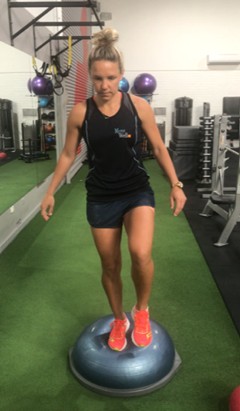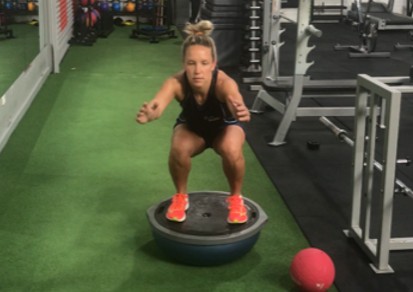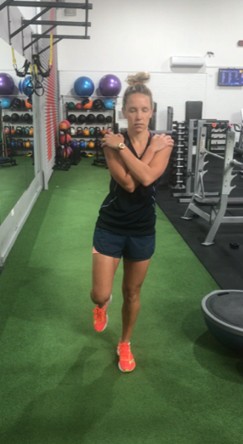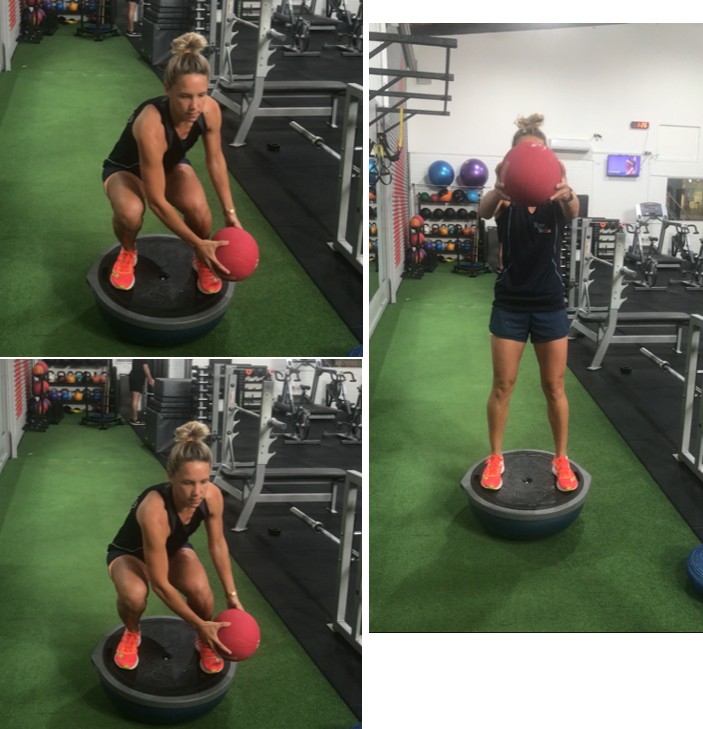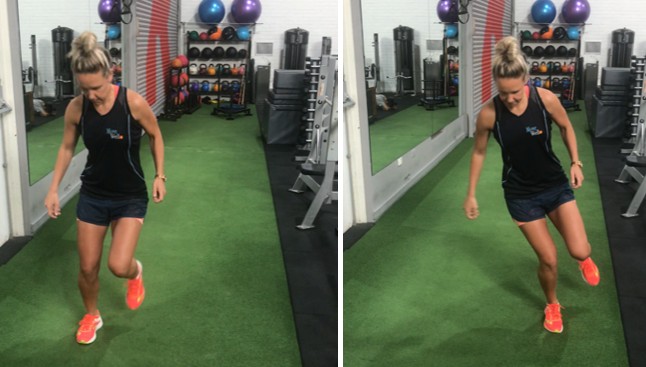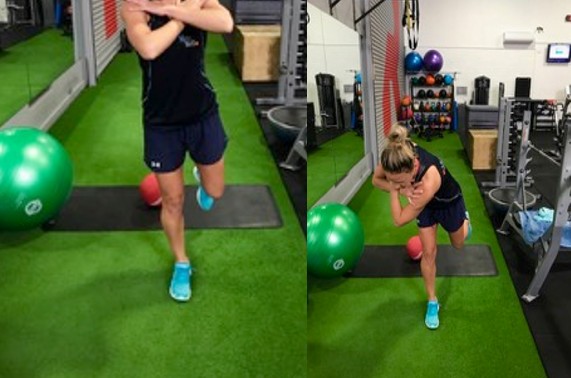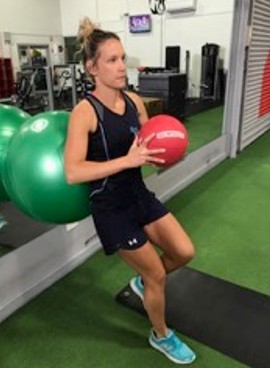Move Well Physiotherapy
PROPRIOCEPTION PROGRAM
What is proprioception?
Proprioception is the bodies ability to transmit a sense of position, analyse that information and react consciously or unconsciously to the stimulation with the proper movement (Houglum 2001). For example: Elite athletes are not thinking about how to stay balanced as they hit a hockey ball or kick a soccer ball at goal.
It all just happens automatically behind the scenes! This is what makes the best athletes focus on the task at hand and not wasting their mental and physical energy on focusing on staying on their feet! More information at the foot of the page.
1. Wobble Board / Bosu Ball
1a) ONE LEG BALANCE – Stand on a wobble board/Bosu ball on one leg. Keep leg slightly bent and try and hold this position for 10-30 seconds.
Repeat on the other leg
1b) HALF SQUAT – Stand on the wobble board/bosu ball. Keep your feet facing forwards and your feet at shoulder-width apart. Squat downwards and stop at mid-way down and then stand back up.Make sure that your knees do NOT collapse over your toes. If you are struggling with your balance try and focus on a spot on the ground.
Repeat 12 reps
1c) – Only perform this on a Bosu ball if you can do 1a) for 30 seconds. If you can’t hold that position do this exercise on the GROUND. Stand on one leg with your arms crossed as if you were hugging yourself. Hold this position and now close your eyes.
Try to hold this position for 10-30 seconds then repeat it on the next leg
2. Squat – Ball to Opp Side
To start this exercise you will NOT start on a bosu ball but will advance to it once you improve your balance. Hold a 4 kg medicine ball at your chest. Squat down and reach across with the medicine ball to your right side then stand back up and repeat on the left side
Repeat 6 reps each side
3. Resistance Band Jumps
Anchor a band to a fixed object. Attach the band around your waist. When ready you are going to jump diagonally to the right and stay balanced on your right foot for 2 seconds and then jump diagonally to the left and hold this for 2 seconds. When the resistance is too much to jump any further walk back to starting position.
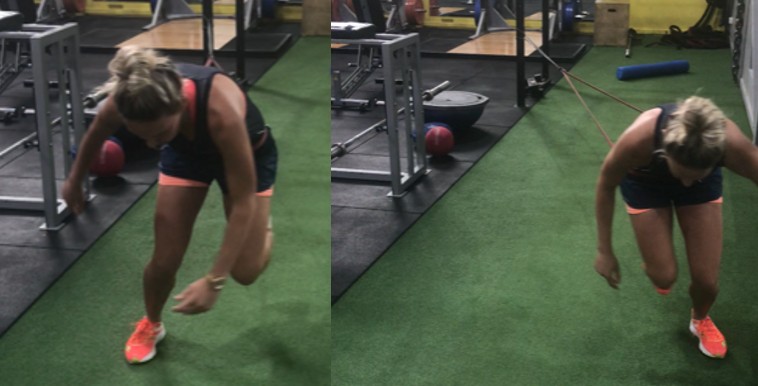
4. T-Hops
Stand on one leg. Keep this leg slightly bent. When ready Jump forward then to the right then to the middle and then to the left. That counts as 1 rep. You will hop as if you are hopping the letter T.
Repeat 6 times and then do it on the left leg
5. Single Leg Elbow Rotation
Cross your arms, and hold your shoulders. Stand on your right leg to begin with and when balanced, drop your torso slightly forward and rotate so that your opposite elbow passes the line of your knee. Hold this position for 2 seconds,while keeping your balance and then return to starting position.
Repeat the same exercise on your left leg
6. Medicine Ball Catch
Sit on a exercise ball. Once balanced lift your left leg up off of the ground so that it is almost at 90 degrees. When ready ask a friend to stand about 1 meter away from you and throw the weighted ball to each other (DO THIS IN A SLOW AND CONTROLLED MANNER). If this makes you feel slightly unstable, tighten your trunk and drop weight of weighted ball if necessary. This is a great exercise as this exercise allows proprioceptive ability to be trained whilst only putting partial weight through the affected limb.
Repeat the same exercise using your left leg
7. Advanced to Standing
Advanced weight bearing proprioceptive exercise. Only advance to this exercise once you are comfortable with the exercise above. Instead of sitting you will be leaning against a exercise ball in a slight squat position. Your friend will pass you the weighted ball as described above. Repeat the same exercise on your left leg. If you are alone and do not have assistance, you are able to do the same exercise but an alternative to this would be for you to take the ball, extend your arms out and hold the ball in line with your chest. Keeping your arms straight lift the ball forward and above overhead then slowly lower it down. This counts as 1 rep.
Proprioception is the bodies ability to transmit a sense of position, analyse that information and react consciously or unconsciously to the stimulation with the proper movement (Houglum 2001)
For example: Elite athletes are not thinking about how to stay balanced as they hit a hockey ball or kick a soccer ball at goal.
It all just happens automatically behind the scenes! This is what makes the best athletes focus on the task at hand and not wasting their mental and physical energy on focusing on staying on their feet!
Proprioception consist of both sensory and motor nerves that sends and receives impulses to and from the Central Nervous System from stimuli within the skin,muscles, joints.These impulses transmit vital information such as the amount of tension in a given muscle and the relative position of a body part during a given movement. (Houglum 2001)
Before doing this program it is vitally important that you see your trusted Move Well Physiotherapist, to ensure that you are doing the right proprioception exercises, reps and sets. Fail to do so, you may hinder your recovery rate or disrupt tissue repair! Improving proprioception requires PROGRESSION, just as improving strength and endurance does!
2. Can you LOSE proprioception?
Yes, EVERY injury has the potential to decrease your proprioception and balance. For example: when you roll your ankle and have a ligament sprain, you may experience an unstable feeling in the joint.
3. How do you increase your proprioception and balance after injury?
These specific proprioception exercises are designed to increase your proprioception feedback circle.
4. Why train proprioception?
When training proprioception the main aim is to INCREASE (S.A.M) Stability, Agility and Mobility! By improving your proprioception athletes gain balance skills necessary to maintain STABILITY improve their AGILITY so that they can quickly change direction without going over their ankle. Training proprioception will also increase the MOBILITY within the specific joint. Training S.A.M will help you fine tune coordination and skill so that you can perform physically activity accurately and consistently!
5.What type of equipment is used to train proprioception?
– Exercise ball
– Wobble board
– Soft foam
– Balance pads



